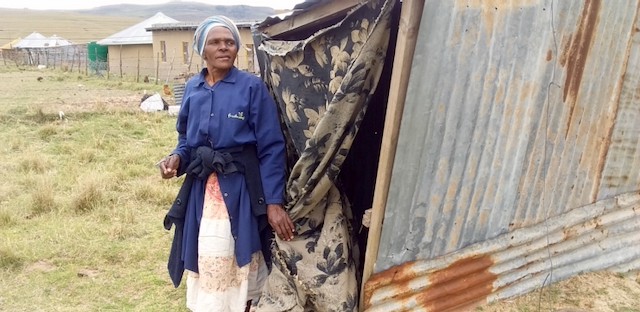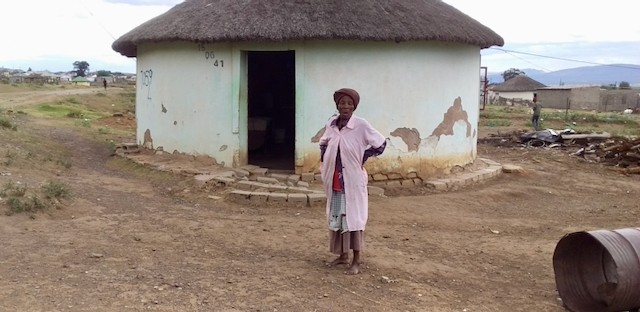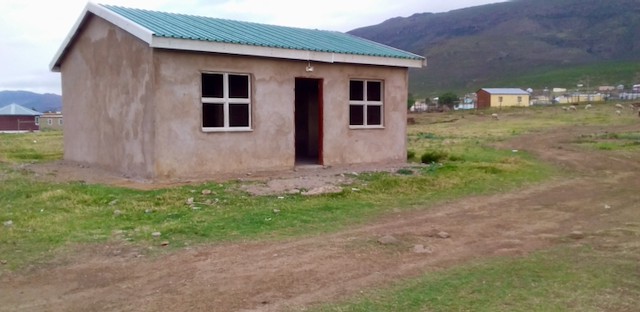Corruption or incompetence? Rural Eastern Cape housing projects delayed for years
And a company that was paid R1.5 billion in tenders left households in Cofimvaba each with a pile of concrete slabs instead of toilets
Cornelia Rani, who is 62 and lives with her very elderly mother in Luxhomo village, showed us her makeshift toilet. “What saddens me mostly is to see my mom having to use this toilet,” she said. All photos: Nombulelo Damba-Hendrik
- A housing project started in villages around Cofimvaba, Eastern Cape, six years ago is still not complete.
- The Eastern Cape human settlement department says the delays have been due to disputes with local contractors.
- Also in Cofimvaba, villagers are without toilets after the contractor left each house six months ago with a pile of five concrete slabs.
- Izwelethu Cemforce was paid R1.5 billion in tenders and meant to supply toilets for two municipalities. The company is being investigated by the Hawks.
Many Cofimvaba residents who had expected to have RDP houses by 2017 are still waiting for their houses to be completed.
In 2015, a Gauteng-based company, Vuikani construction, was awarded an R82-million tender to build 489 houses in villages around Cofimvaba in the Eastern Cape.
By October 2019, the construction company had only completed 95 houses (less than 20%) of the job. A further 140 houses were partly completed and 254 houses had not yet been started.
Vuikani then returned to Bolokodlela village in Qamata ward 2, raising residents’ hopes.
Nowes Marhenene says that when the company returned, they told her that the walls, which was all that had been built of her house, did not meet standards. They then demolished them. The company started rebuilding, but once again left a few weeks later before her house was finished.
“Only three houses were handed over. There was no explanation. They just left,” she said.
We counted seven unfinished RDP houses. A number of residents said Vuikani hadn’t even started building their homes.
At least Marhenene’s house now has a roof and windows and outside doors. But there is no electricity, ceiling, plumbing or paint.
Nomathemba Ncamile, who is 72 this year, said she doubts she’ll live long enough to see an RDP house.
“When the construction company came back in 2019, they said they will start with my house because it appeared in the [GroundUp] article … But that did not happen. They left it unfinished and no one knows when they are going to come back,” she said.
Ncamile currently lives in a two-roomed mud house and a rondavel. She has used rocks to keep the roof from blowing away.
“It’s been four years now waiting,” she said.
Resident Notimile Dani said people want the tender to be given to a company that can finish the job.
Nowes Marhenene lives in this rondavel while she waits for her RDP house
In another area, where Vuikani also left RDP houses unfinished in 2016, MMM Construction has taken over, according to Ward 4 Councillor Manyewu Shasha. He said good progress has been made and only a few houses are left to be finished.
Five days after we sent a media inquiry to Yanga Funani, spokesperson for the Eastern Cape Department of Human Settlements, Vuikani returned to Bholokodlela to paint the houses of Ncamile and Marhenene.
Funani blamed the delays on disputes between subcontractors and the local contractor stopping Vuikani from working.
Funani said all beneficiaries will receive their houses before March 2022. He said 21 houses are at finishing stage, 12 have slabs, and 16 are still to be started.
Vuikani Managing Director Sibusiso Makwendini admitted there had been delays.
He said the unfinished houses in Bolokodlela were caused by a local subcontractor who obstructed them and stopped them completing the units.
He said there are approximately 40 houses not completed in the project. Of these, 15 are in remote Madakana and will be completed in the next two months.
Izwelethu Cemforce, which won over R1.5 billion in tenders, left villagers with just a pile of concrete slabs on the ground, like this one, six months ago and never returned.
Meanwhile in Magwala, Wodehouse and Isikhoba villages, Izwelethu Cemforce was contracted by Chris Hani District Municipality to build toilets.
The Directorate for Priority Crime Investigation (Hawks) is investigating the awarding of tenders by two municipalities to Izwelethu Cemforce. National spokesperson Brigadier Nomthandazo Mbambo said over R1.5 billion was paid to the company.
All the company did in Luxhomo was to leave each household with five loose concrete slabs, presumably to assemble a toilet. No pits were dug or any other work done.
Resident Nozintombi Ntinga uses her neighbour’s toilet but often has to use a bucket at night and an open field during the day. “We do not know when these toilets will be built,” she said.
Chris Hani District Municipality spokesperson Bulelwa Ganyaza said the matter is the subject of an investigation and she cannot provide further details.
Izwelethu Cemforce’s Queenstown office referred us to its head office in Kimberley. A person answering the phone, who refused to give her name, said the company had no comment.
One of the unfinished RDP houses in Cofimvaba’s Bolokodlela village.
Support independent journalism
Donate using Payfast

Don't miss out on the latest news
We respect your privacy, and promise we won't spam you.
Next: Immigrants tough it out in Joburg’s “dark buildings”
Previous: None of the Above wins local elections
© 2021 GroundUp. This article is licensed under a Creative Commons Attribution-NoDerivatives 4.0 International License.
You may republish this article, so long as you credit the authors and GroundUp, and do not change the text. Please include a link back to the original article.
We put an invisible pixel in the article so that we can count traffic to republishers. All analytics tools are solely on our servers. We do not give our logs to any third party. Logs are deleted after two weeks. We do not use any IP address identifying information except to count regional traffic. We are solely interested in counting hits, not tracking users. If you republish, please do not delete the invisible pixel.




